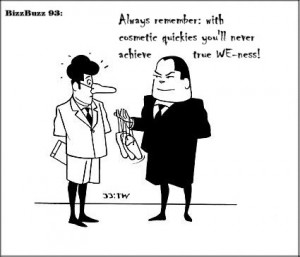|
|
|
Wednesday, September 30th, 2015

No matter your age healthcare is/should be a serious concern.
If not for yourself then for your parents and others you care about.
And not just a new app that delivers services a different way, no matter how good.
What needs to change is the culture of not only insurance companies, but medical service providers (doctors, labs, testing, hospitals, etc.), other various and sundry vendors within the ecosystem, not to mention the government in the form of Medicare and Medicaid.
When you look at the deeply entrenched interests on that list the possibility of anything actually happening in the near-term seems remote, if at all.
Not even the proverbial 500 pound gorilla, think Google or Facebook, has the clout to even dent that crowd.
But what about Aetna Insurance under CEO Mark Bertolini, a 1000 pound gorilla and long-time global player in healthcare that has the clout, since it insures two thirds of the Fortune 100 and a great number of the 500?
…Bertolini called the sector “too bloated and accountable to no one.” The system — which will cost US$4.6 trillion, or 20 percent of U.S. GDP, by 2020 — “charges patients and rewards care providers on services delivered, not patient outcomes,”…
Aetna is taking a three prong approach that includes, paying for positive outcomes, as opposed to fees for services; changing corporate health offerings in order to tap into positive consumer behavior and eating its own dog food — as every good startup does.
The big question is whether Aetna will walk its talk.
Based on the comments it’s questionable.
Flickr image credit: Aetna
Posted in Change, Culture | No Comments »
Monday, April 27th, 2015

Having trouble getting people to do things differently or do something new?
According to Henry Thoreau, “Things don’t change, people do.”
Over the years, I’ve watched managers and companies try to change the outcome without changing the input.
They’ve talked/explained/begged/pleaded/threatened, but nothing changes.
They are suffering from Einstein’s version of insanity.
Doing the same thing over and over again and expecting different results.
If change is the goal, it’s best to start with yourself.
“To change what they do, change how you think.”
You need to change because the way you think, what you think, how you think, and what you believe — in other words your MAP — dictates the authenticity of what you do and the responses you get.
No matter what great ideas you read, hear or talk, no matter what great leader you try and channel, you will always walk your own MAP.
Image credit: Newtown graffiti
Posted in Change, Personal Growth | No Comments »
Wednesday, September 17th, 2014
 Bosses are enamored with culture and rightly so. Bosses are enamored with culture and rightly so.
However, for culture to work its wonders it must sink deeply into the organization in the same way that stain is absorbed by wood.
Cultural stain is the direct result of walking the talk and making sure that everybody else walks it, too.
It’s intentional action and it requires paying attention.
It must be applied carefully or every imperfection and flaw in the organization will be on display.
Stain is never the output of an underling; when ideas do bubble up from other parts of the organization they won’t take root without the support of the boss, whether publicly or not.
The problem is that many bosses find it faster to treat culture like paint.
Cultural paint is easier to apply and, like real paint, it can hide everything from minor blemishes to dry rot.
It’s paid lip-service, with effects that are grounded in convenience and often included only to make the employees feel good.
What paint-loving bosses forget is that the more coats of paint are applied the more likely is it to peel.
People aren’t stupid and will vote their displeasure with their feet.
Flickr image credit: maurice.heuts
Posted in Communication, Culture | No Comments »
Friday, September 12th, 2014
A Friday series exploring Startups and the people who make them go. Read all If the Shoe Fits posts here
 Founders constantly talk about their need for ‘self-starters’ and ‘independent workers’. Founders constantly talk about their need for ‘self-starters’ and ‘independent workers’.
They look for people who will ‘take the ball and run with it’.
They want high initiative and creative problem-solving.
What they really crave is a self-managing workforce or as close as they can get.
The disconnect results from the differences between what they say and their MAP.
If MAP fears any of the following then there is no way the walk can live up to the talk.
And while the answers to these questions require being brutally honest with yourself, they do not require being made public.
- Does letting go/delegating equal loss of control?
- Is your self esteem tied to methodology or accomplishments (AKA, your way or the highway)?
- Do you believe it’s more important that work is done well, than where or how it happens?
- Does your self-esteem equate control to power?
- Do you believe that people are intelligent, motivated and really care about their company’s success, OR that they are that you need to watch them every minute if anything is going to get done?
- How much of a micromanager are you?
Once you identify attitudes that need to change it’s up to you to modify your MAP as needed.
MAP can be changed, but those changes must originate internally—they can’t be forced by circumstances or other people, although either can be motivators.
Image credit: HikingArtist
Posted in Entrepreneurs, If the Shoe Fits, Personal Growth | No Comments »
Tuesday, January 29th, 2013
 If you are a manager at any level I suggest you take time to read the results of research on managing from the London School of Economics. If you are a manager at any level I suggest you take time to read the results of research on managing from the London School of Economics.
“…concentrate on putting into practice things that we know work but somehow never do — less Management 2.0, more making Management 1.0 work properly. At least on the face of it, a surprising amount can be altered for the better, with little investment and to significant effect. (…) focus on why we don’t put into practice principles of good management that aren’t rocket science and have been known about for years.”
Management by walking around, spending time with your team; listening; coaching; cross-training—definitely not rocket science!
Your approach need not be as tightly structured as described in the article, because that was done in order to rigorously evaluate and measure the results for publication.
Basically the study proves what the best managers already know and practice—it’s people that make the difference and the difference is measurable.
You can achieve similar results in your group, whether your company uses the same approach or not.
Set your own goal to practice Management 1.0 actions consistently and authentically.
Then (as Nike says) just do it.
Flickr image credit: Ol.v!er [H2vPk]
Posted in Culture, Ducks In A Row | No Comments »
Friday, January 27th, 2012
A Friday series exploring Startups and the people who make them go. Read all If the Shoe Fits posts here
 I seem to write too many stories about bosses who don’t walk their talk, which, I realize, is an overused, hackneyed expression. I seem to write too many stories about bosses who don’t walk their talk, which, I realize, is an overused, hackneyed expression.
But that doesn’t mean it’s not an accurate one.
Here’s the background and I have to admit it really floored me.
“Mark” is a thirty-something engineer and was the third person to join 23 year old “Jim’s” startup early in 2011.
Out of several offers he chose Jim’s. He’d read and heard a lot about the values that Millennials demanded and Jim’s description of his values and the culture he was building based on them closely matched Marks own.
Things were going well and they had grown to 6 people when they landed on the radar of a major corporation.
Near the end of the year Mark heard a rumor that the company was being acquired.
When he asked Jim if it was true he said it was and that they hoped to keep the staff.
Mark was flabbergasted; not because Jim was selling, but because the acquiring company’s culture was known to be diametrically opposed to almost all of Mark’s stated values.
When Mark said as much Jim said that it was an amazing offer and that he would be a fool to turn it down. Although they could easily raise an investment round, his holdings were far more valuable with the acquisition than if they were diluted by new investors.
Mark asked Jim if he had meant anything he said during the interview or if it was all just BS.
Jim’s response really blew me away.
Mark said he shrugged and said “that was then and this is now.”
What do you think? Was Jim justified? What would you do?
Posted in Culture, Entrepreneurs, Ethics | No Comments »
Friday, November 20th, 2009
 Is your company fair? Is fairness part of your MAP? Are you fair to your people? How often have you heard (or said), “That’s not fair!” Is your company fair? Is fairness part of your MAP? Are you fair to your people? How often have you heard (or said), “That’s not fair!”
People accept that life isn’t fair—more or less. Whereas you can’t walk away from life, but it’s relatively easy to walk away from a company or manager you perceive as unfair.
What do people expect within the business world in terms of fairness?
The obvious is that they don’t want to be shafted a la Enron. However, fairness refers to more than the obvious, most often to the company/manager doing what they said they would do, i.e., walking their talk.
Fairness is what people want and fairness is what most companies/managers promise—but frequently don’t provide. For example:
Fairness excludes politics
- Official – people will be promoted based on what they do
- De facto – people are promoted based on who they know
Fairness is egalitarian
- Official – everybody will fly economy class when traveling
- De facto – senior management flies first class
Fairness includes parity
- Official – similar skills are compensated similarly with any differences the result of merit
- De facto – compensation differences result from expediency, prejudice, or favoritism
Besides doing ‘the right thing’, why be fair? What’s in it for you?
Quite a lot, actually.
Fairness reduces turnover (and its associated costs), increases productivity, and fuels innovation, all of which makes you look good as a manager and gives your company a good street rep. Yes, companies have street reps, too, and those reputations have a major impact on the caliber of people applying; a rep that is positive for fairness makes it easier to higher great people.
All this means better reviews, increased compensation, a reputation that’s pure gold and a great night’s sleep.
What’s not to like? And all you have to do is do as you say you will.
Please join me Monday to learn why fairness is monkey business.
Your comments—priceless
Don’t miss a post, subscribe via RSS or EMAIL
Image credit: RachelH on flickr
Posted in About Business, About Leadership, Personal Development | 4 Comments »
Monday, June 2nd, 2008
Post from Leadership Turn Image credit: Sarah and Nic
Culture is at the forefront of the corporate mindset.
Almost every article and comment regarding the workplace is, directly or indirectly, a comment on culture—what works, or not; what’s needed, or not. Want to innovate? Change the culture. Increase retention? Fix/keep the culture.
For Boards, CEOs, executives and managers at all levels it’s a case of ignore culture at your peril.
Keeping people (customers, employees and investors) is the key to sustainable success and culture is one of the main reasons that people join/buy/invest in a company—and its demise is a major reason why they leave.
Think of a stool with customers, investors/stockholders, and employees comprising the legs and culture being the seat that unites them. Over-favor one leg and it will get too long, ignore another leg and it will shrink, but the end result is the same—the stool tips over.
For everything that’s been written regarding creating good, let alone great, cultures you need to start with the basics:
- Open, honest, constant communications
- Never kill the messenger
- Accept and act on input from all levels
- Walk your talk
Sure, there’s tons more you can do, but I guarantee that if you do only these four you’ll be well on your way to creating a positive, sustainable culture.
What do you do to help create a positive culture in your company?
Your comments—priceless
Don’t miss a post, subscribe via RSS or EMAIL
Posted in About Leadership, Communication, Culture, management | No Comments »
|
 Subscribe to
Subscribe to
MAPping Company Success
About Miki 
Clarify your exec summary, website, etc.
Have a quick question or just want to chat? Feel free to write or call me at 360.335.8054
The 12 Ingredients of a Fillable Req
CheatSheet for InterviewERS
CheatSheet for InterviewEEs™
Give your mind a rest. Here are 4 quick ways to get rid of kinks, break a logjam or juice your creativity!
Creative mousing
Bubblewrap!
Animal innovation
Brain teaser
The latest disaster is here at home; donate to the East Coast recovery efforts now!
Text REDCROSS to 90999 to make a $10 donation or call 00.733.2767. $10 really really does make a difference and you'll never miss it.
And always donate what you can whenever you can
The following accept cash and in-kind donations: Doctors Without Borders, UNICEF, Red Cross, World Food Program, Save the Children
*/
?>About Miki
About KG
Clarify your exec summary, website, marketing collateral, etc.
Have a question or just want to chat @ no cost? Feel free to write
Download useful assistance now.
Entrepreneurs face difficulties that are hard for most people to imagine, let alone understand. You can find anonymous help and connections that do understand at 7 cups of tea.
Crises never end.
$10 really does make a difference and you’ll never miss it,
while $10 a month has exponential power.
Always donate what you can whenever you can.
The following accept cash and in-kind donations:
|






 Bosses are enamored with culture and rightly so.
Bosses are enamored with culture and rightly so. Founders constantly talk about their need for ‘self-starters’ and ‘independent workers’.
Founders constantly talk about their need for ‘self-starters’ and ‘independent workers’. If you are a manager at any level I suggest you take time to read the results of
If you are a manager at any level I suggest you take time to read the results of  Is your company fair? Is fairness part of your
Is your company fair? Is fairness part of your 

